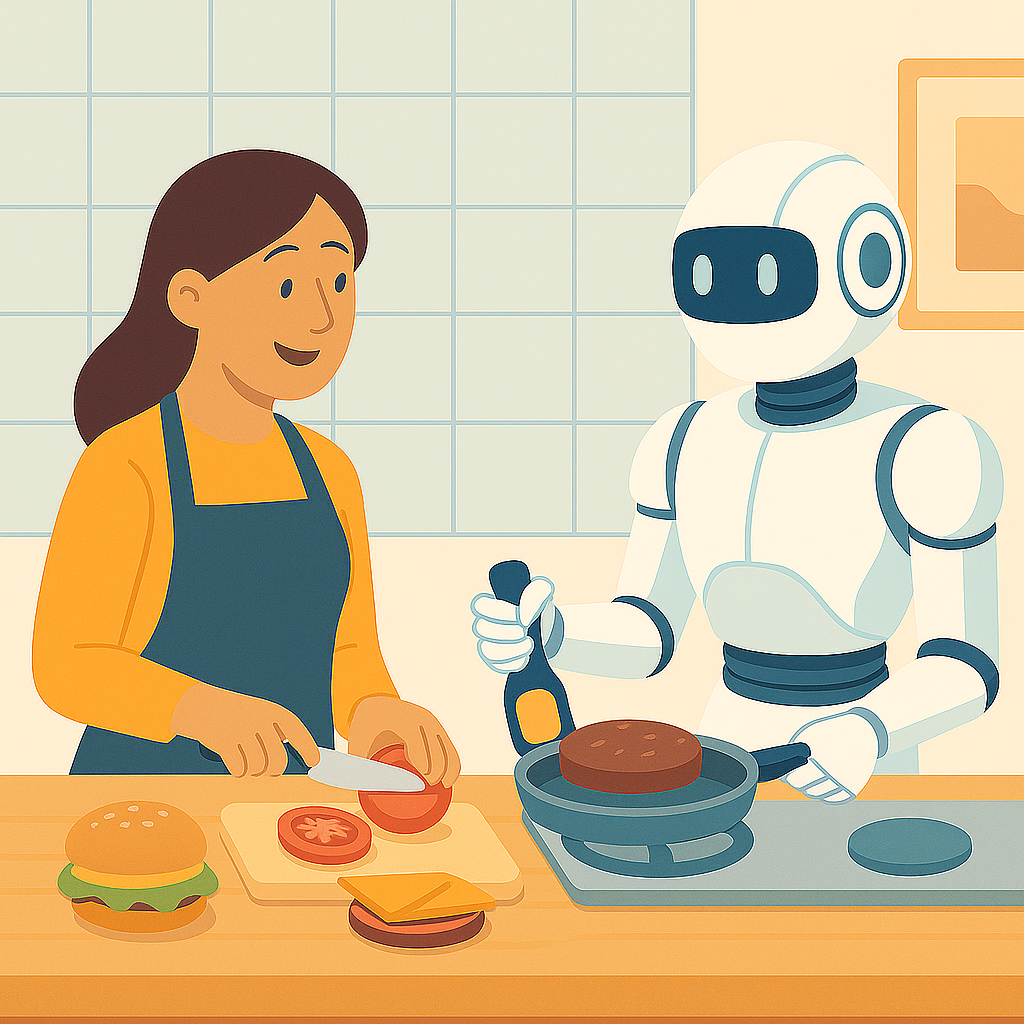Content with soul – AI and why the human touch matters more than ever
Content with soul – AI and why the human touch matters more than ever
A Filling Without the Flavour
How many times have you had a meal at a restaurant or a takeaway that filled the gap but was completely unmemorable? Perhaps you thought to yourself: ‘I could have made this taste better myself’ or ‘I wish I was eating my mother’s/grandmother’s/family member of your choice’s version of this.’ There’s no doubt that it was easy, convenient and even nutritious to eat but it lacked something. Famous chef and cookbook author Thomas Keller sums it up when he says: ‘A recipe has no soul. You as the cook must bring soul to the recipe.’
We’re fond of a well-prepared meal here at The Learning Studio and we believe great content follows the same principle: the best tools and ingredients matter, but it’s the human touch that brings depth, warmth, and soul to the final plate.
AI can provide all the right ingredients: the facts, the structure, even a decent flavour base. It’s unmatched in its ability to accelerate content development but all too often, the results are bland, biased and even erroneous. While MacDonalds and KFC have built their business model around delivering identical products every time, it’s really not an ideal outcome for instructional design and content creation.
If, like us, you can see the advantages of using AI but you’re also concerned about quality, time and budget – read on!

Recipes Are Easy; Great Meals Are an Art:
Most people these days have access to AI and many ‘use’ it. Very few however, can ‘orchestrate’ it. Just like cooking – everyone eats, almost everyone cooks, but not many can take basic ingredients and turn them into a delicious, plate-cleaning feast.
We’re currently dealing with a tsunami of ‘AI slop’. Poorly prompted, rapidly generated imitations that are all frighteningly similar and horribly dull. Type in a common search term and you get multiple articles that are immediately identifiable as AI derivative.
What’s needed is a human-led process that directs and integrates AI purposefully, ensuring that the automation supports strategy, quality and creativity rather than replacing them. Orchestration is the skill of knowing which tasks to hand to the machine, which decisions need human judgement, and how to blend the two for results that are faster, smarter, and unmistakably human.
AI as the Prep Cook
A skilled prep cook chops, measures, and organises ingredients to save the chef time, and AI does the same, speeding up the groundwork in content development. Here are some of the ways we use it:
- Rapid Drafts and Outlines
AI turns a blank page into a starting point, generating draft structures and outlines in minutes so our writers can focus on refining tone and flow. - Alternate Versions and Adaptations
It creates quick variations of the same piece: short, detailed, formal, or conversational, helping us test what fits best across formats and audiences. - Accessibility and Inclusivity
AI can instantly produce transcripts, captions, or simplified versions, making materials more accessible before humans refine for clarity and empathy. - Language Support
It accelerates translation and localisation, suggesting phrasing and tone that our editors then adjust for nuance and cultural fit. - Quality Assurance
AI’s a tireless proofreader, spotting grammar slips, style inconsistencies, and formatting errors before human review adds polish. - Quiz Item Banks and Transcript Clean-Ups
It generates draft questions and tidies transcripts, giving subject experts more time to focus on accuracy and learning value. - Time and Cost Savings
By streamlining repetitive work, AI reduces production time and costs — letting our people invest energy where creativity and judgement count most.

AI Fast Food, Speed over Quality
Fast food fills you up but it’s not the meal you rave about afterwards. In the same way, AI-generated content can look polished, tick all the boxes, and deliver information quickly, yet still leave you unsatisfied. It’s fast, convenient, and consistent but often lacks depth, originality, and flavour. That’s because AI follows patterns, not purpose. It doesn’t understand your learners, your brand, or the subtle shifts in tone that make material feel alive.
And when AI runs the kitchen unchecked, a few things can also start to go wrong:
- Hallucinations – ingredients that don’t exist.
AI has a habit of inventing facts or sources, a bit like adding a mystery spice that no one ordered. It may sound convincing, but it risks serving your audience misinformation, undermining credibility and trust. - Generic Tone – flavourless presentation.
AI writes for everyone and ends up sounding like no one. It’s the equivalent of an over-processed meal: smooth, uniform, and entirely forgettable. Without a human hand to add personality and voice, the result feels flat and soulless. - Cultural Misses – seasoning that doesn’t suit the palate.
Machines don’t intuit culture or context. They can misjudge idioms, humour, or references. Human review ensures every piece respects audience diversity and feels naturally relevant. - Copyright and Data Risks – tainted ingredients.
AI draws from vast public sources, not all of them clean or compliant. Using unverified material without human checks can introduce ethical, legal, or brand risks — the content equivalent of food contamination
Kerushan Naidoo
Head of Moodle Development
Kerushan has a decade of experience working wonders with Moodle. That’s why we rely on this man for the winning plan. He is an active Moodle community member and, either knows of the perfect plugin for your needs, or will customise and develop a plugin to meet your unique requirements.
